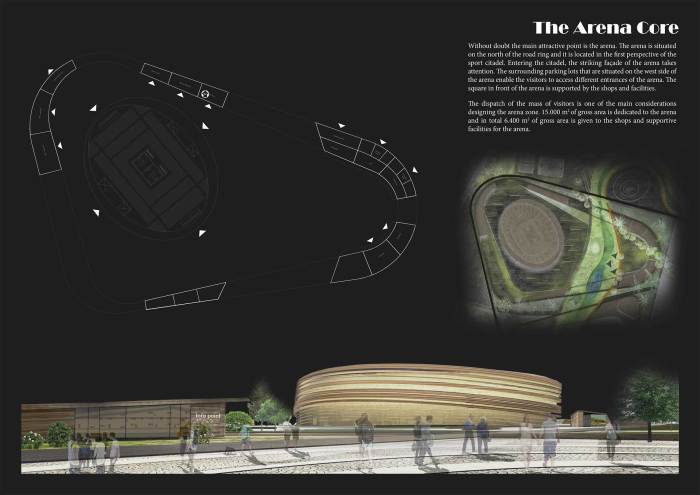Metabolist Architecture A Vision for the Future
Metabolist architecture, a revolutionary approach to design, emerged from post-war Japan, envisioning cities as dynamic, living organisms. This architectural movement sought to integrate technology, nature, and societal needs harmoniously, creating spaces that could adapt and evolve with the changing times. Key figures like Kenzo Tange and Kisho Kurokawa played pivotal roles in shaping this exciting vision, pushing boundaries and questioning conventional architectural norms.
This exploration will delve into the core principles of metabolist architecture, examining its unique design philosophies, innovative technological applications, and profound impact on urban planning. We’ll trace its historical roots, analyze its key figures, and compare its concepts to other architectural movements. Finally, we’ll assess its enduring legacy and its relevance to contemporary challenges in urban development.
Defining Metabolist Architecture
Metabolist Architecture, a significant movement in postwar Japanese architecture, sought to transcend conventional architectural approaches. It envisioned buildings as dynamic entities, constantly evolving and interacting with their surroundings. This innovative approach emphasized organic growth, technological integration, and a deep connection with the environment.
The movement emerged from the post-World War II era in Japan, a period of profound societal and economic transformation. The devastation of the war, coupled with rapid industrialization and a growing awareness of ecological concerns, fueled a desire for a new architectural language that reflected these changes. This era fostered a unique blend of futuristic ideals and a sensitivity to environmental considerations, paving the way for Metabolist Architecture.
Key Characteristics of Metabolist Architecture
Metabolist Architecture is characterized by its emphasis on organic forms, adaptability, and technological innovation. Structures are conceived as dynamic entities, capable of evolving and responding to changing needs and environments. The integration of technology into the design process is central, with a focus on modularity and prefabrication. A deep respect for the environment is also evident, as buildings are designed to seamlessly integrate with the surrounding landscape and natural processes.
Historical Context and Influences
The Metabolist movement emerged in a period of reconstruction and rapid industrialization in post-war Japan. This context profoundly influenced the architectural principles and philosophies. The devastation of the war highlighted the need for resilient and adaptable structures. Rapid technological advancements fueled a sense of optimism about the potential of technology to reshape the built environment. A deep respect for nature and the importance of ecological sustainability became key considerations in the design process.
Core Principles and Philosophies
Metabolist Architecture rests on several core principles. A central idea is the concept of “metabolism,” signifying the dynamic and evolving nature of both buildings and their surroundings. The principle of adaptability is also key, recognizing the ever-changing needs of society and the environment. A deep respect for technology and its potential for shaping the built environment is also a defining aspect. The philosophy of organic growth, emphasizing continuous evolution and renewal, was instrumental in shaping the Metabolist aesthetic.
Key Figures and Contributions
The Metabolist movement brought together a group of influential architects, each contributing to the development of this unique architectural style. The following table highlights key figures and their contributions.
| Architect | Key Contribution | Year of Contribution | Image Description |
|---|---|---|---|
| Kenzō Tange | A key figure in the movement, Tange’s contributions spanned various aspects of Metabolist theory, including the concept of the city as a dynamic organism. | 1950s-1970s | A design for a high-rise tower emphasizing the interconnectedness of urban spaces and the dynamic qualities of the urban environment. The structure showcased a layered, vertical cityscape. |
| Kisho Kurokawa | Kurokawa’s innovative approach to architecture emphasized the integration of technology and the concept of a dynamic, evolving city. | 1950s-1970s | A design for a housing complex incorporating modular units and prefabrication, demonstrating the integration of technology into architectural design. The image showcased the innovative use of materials and adaptable design for the structure. |
| Fumihiko Maki | Maki’s designs often incorporated a sense of openness and fluidity, reflecting the dynamic nature of the city and the human experience. | 1950s-1970s | A design for a public space emphasizing the interaction between the building and its surroundings. The image showcased the seamless integration of architecture with nature, creating an open and dynamic public space. |
Design Principles and Concepts

Source: squarespace-cdn.com
Metabolist Architecture, emerging in post-war Japan, presented a radical departure from conventional architectural approaches. It emphasized dynamic, evolving spaces, reflecting the rapid societal and technological transformations of the era. This approach prioritized the integration of technology and nature, aiming to create buildings that interacted organically with their environment.
Key to understanding Metabolist design is the concept of “metabolism,” envisioning architecture as a living entity that responds and adapts to its surroundings, much like a biological organism. This dynamic vision significantly impacted the principles of flexibility, organic form, and technological integration, ultimately shaping the aesthetic and functional characteristics of Metabolist projects.
Key Design Principles, Metabolist Architecture
Metabolist designs prioritize flexibility and adaptability, acknowledging the ever-changing needs of society. This is realized through modular components and adaptable structures, allowing buildings to evolve and transform over time. Organic forms, inspired by biological processes, are another defining characteristic, seeking to create seamless integration between architecture and nature. This pursuit of fluidity and dynamism is achieved through curved lines, free-flowing spaces, and non-orthogonal configurations. Technological integration is fundamental, aiming to utilize innovative materials and construction methods. This includes prefabrication, modularity, and the seamless incorporation of advanced technologies into the design.
Metabolic Growth
The concept of “metabolic growth” in Metabolist architecture signifies the continuous adaptation and transformation of a building throughout its lifespan. Imagine a building evolving in response to changing needs, much like an organism grows and adapts to its environment. This concept translates into adaptable layouts, flexible spaces, and modular components, enabling the building to accommodate future requirements. An example of this can be seen in the expansion of living spaces over time, as families grow and needs change, or the conversion of a commercial space into a residential one as demands shift.
Prefabrication and Modularity
Prefabrication and modularity were crucial to the Metabolist philosophy. These techniques, which involve producing components off-site and assembling them on-site, facilitated flexibility, speed, and cost-effectiveness. The modularity enabled the construction of diverse forms and layouts by combining prefabricated elements. This method also supported rapid adjustments and additions to existing structures as needs evolved. This approach contrasts significantly with traditional on-site construction methods, offering significant advantages in terms of adaptability and cost efficiency.
Innovative Use of Materials and Technologies
Metabolist architects sought to push the boundaries of material use and technological application. Innovative materials, like reinforced concrete and lightweight steel, allowed for the creation of complex forms and structures. Furthermore, the integration of advanced technologies, such as elevators, moving walkways, and integrated systems, was not just a practical consideration but an integral aspect of the design philosophy. This emphasis on technology as an integral part of the building’s function and aesthetic is reflected in the imaginative incorporation of mechanical elements.
Comparison with Other Architectural Movements
| Architectural Movement | Key Characteristic 1 | Key Characteristic 2 | Comparison to Metabolist |
|---|---|---|---|
| Modernism | Emphasis on functionalism | Geometric forms | Metabolists embraced technology and organic forms, diverging from Modernism’s focus on rigid geometries. |
| Brutalism | Use of raw, exposed concrete | Monumental scale | Metabolists used concrete but in a more organic and adaptable way, while Brutalism tended towards monumental and static structures. |
| Organic Architecture | Blending with the natural environment | Fluid and flowing forms | Metabolists took this to the next level by incorporating technology and dynamic adaptation into their organic forms. |
Spatial Organization and Urban Planning
Metabolist architects envisioned cities as dynamic, evolving organisms, constantly adapting to the needs of their inhabitants and the environment. This organic approach to urban planning emphasized the integration of nature and technology, creating spaces that were both functional and aesthetically pleasing. Their vision moved beyond static designs towards a more fluid and responsive urban model.
Their urban planning philosophy was rooted in the concept of “urban metabolism,” recognizing the city as a complex system that consumes resources and generates waste. This understanding profoundly influenced their designs, aiming for a sustainable and self-sufficient urban environment. They envisioned cities capable of self-regeneration and adaptation.
Metabolist Urban Vision
Metabolist architects envisioned cities as intricate systems, not just collections of buildings. They sought to create urban environments that responded to the demands of a growing population while minimizing environmental impact. This involved considering factors like resource consumption, waste management, and the integration of nature within the urban fabric. Their approach was holistic, considering the interconnectedness of various elements within the urban ecosystem.
Urban Metabolism Concept
The concept of “urban metabolism” is central to Metabolist urban planning. It describes the flow of resources, materials, and energy within a city, much like the metabolic processes of a living organism. This concept emphasized the cyclical nature of resource use and waste management, promoting self-sufficiency and sustainability. It recognized that cities are not isolated entities but rather integral parts of a larger ecological system. A successful urban metabolism would minimize waste and maximize the reuse of resources.
Spatial Organization Strategies
Metabolist projects often employed unique spatial organization strategies, including vertical layering, interconnected networks, and adaptable spaces. Vertical layering allowed for efficient use of land while maximizing access to light and air. Interconnected networks facilitated the flow of people and resources, creating a sense of community and accessibility. Adaptable spaces, designed to change over time, allowed the city to respond to evolving needs and technological advancements.
Examples of Metabolist Urban Planning Proposals
Several Metabolist proposals illustrate their innovative approach to urban design. For example, the “Spiral City” concept envisions a series of interconnected, spiraling towers, maximizing the use of vertical space and promoting efficient transportation networks. Another example is the “Cellular City” model, featuring modular, interconnected buildings that can be easily expanded or modified. These proposals emphasized a flexible and adaptable urban form, capable of responding to future challenges.
Integration of Nature into Urban Environments
Metabolist architects emphasized the integration of nature into urban spaces, recognizing the vital role of greenery and open areas. Their proposals often incorporated gardens, parks, and other natural elements into the urban fabric, fostering a connection between people and the environment. This integration aimed to create a healthier and more aesthetically pleasing urban landscape.
Hypothetical Metabolist City Layout (Flow Chart)
+-----------------+
| Resource Hub |
+-----------------+
| | |
| V |
+-----------------+
| Vertical Tower |
+-----------------+
| | |
| V |
+-----------------+
| Green Spaces |
+-----------------+
| | |
| V |
+-----------------+
| Community Hubs|
+-----------------+
|
V
+-----------------+
| Transportation|
| Network |
+-----------------+
This hypothetical flow chart depicts a basic structure for a Metabolist city, illustrating the interconnectedness of its components. The city’s structure is organized around resource hubs, vertical towers, green spaces, community hubs, and a sophisticated transportation network. Each element is interconnected, promoting efficient resource distribution, accessibility, and environmental sustainability.
Technological Advancements and Innovation
Metabolist architects weren’t merely interested in aesthetics; they envisioned a dynamic, adaptable architecture that responded to the rapid advancements of their time. They sought to integrate technology seamlessly into the design process, aiming to create structures that could evolve and adapt to changing needs and societal shifts. This innovative approach reflects a deep understanding of Japanese culture’s emphasis on harmony with nature and a pragmatic approach to problem-solving.
The Metabolist movement viewed technology as a crucial tool for addressing societal challenges, recognizing its potential to improve living conditions and foster a more sustainable future. This philosophy drove their exploration of novel construction methods, materials, and mechanical systems, which aimed to create structures that were both aesthetically pleasing and functionally efficient.
Prefabrication and Modular Construction
The Metabolist approach to construction emphasized prefabrication and modularity. This involved creating standardized components in factories, which were then assembled on-site. This approach reduced construction time, minimized waste, and enabled greater flexibility in design. It also allowed for the adaptation of structures to changing requirements. Prefabrication reflected the efficiency and industrialization ideals of the post-war era.
Integration of Mechanical Systems
Metabolist architects saw the integration of mechanical systems as a defining feature of their designs. This included the incorporation of sophisticated HVAC, lighting, and communication systems. This reflected a desire to create buildings that were not only aesthetically impressive but also highly functional and responsive to the needs of inhabitants. The integration of these systems showcased a commitment to creating a living environment that embraced technological advancements.
Influence of Japanese Architecture and Culture
Japanese architecture, with its emphasis on natural materials and harmony with the surrounding environment, deeply influenced Metabolist design. The concept of “ma” (space) and the use of flexible, adaptable spaces are evident in their designs. This cultural influence manifested in their approach to modularity, sustainability, and a deep respect for nature. The incorporation of these aspects into Metabolist designs provided a unique perspective on modern architecture.
Examples of Innovative Buildings
Several buildings showcased the Metabolist approach to integrating technology and innovative construction techniques. The concept of a dynamic city and adaptable buildings influenced several designs. The design approach aimed to produce buildings that could adapt and evolve.
Technological Approaches in Metabolist Buildings
| Building | Technology 1 | Technology 2 | Impact |
|---|---|---|---|
| Nakagin Capsule Tower | Modular construction | Vertical transportation systems | Demonstrated adaptability and efficient use of space; showcased innovative building techniques. |
| Hiroshima National Museum of Contemporary Art | Innovative use of glass and steel | Natural light integration | Created a contemporary and adaptable space that reflected the movement’s vision. |
| Kagawa Prefectural Central Library | Flexible interior layout | Integration of advanced technology | Showcased the adaptability and functionality of the structure. |
Critical Evaluation and Legacy

Source: thearchitecturedesigns.com
The Metabolist movement, despite its limited built output, left a profound mark on architectural thought and practice. Its innovative approach to urban planning and its embrace of technological advancement continues to resonate with contemporary concerns about sustainability, adaptability, and the relationship between humans and the built environment. The movement’s influence is visible in a variety of architectural styles and urban planning approaches, from sustainable design strategies to the development of flexible and responsive structures.
Reception and Influence on Subsequent Movements
The Metabolist movement’s influence on subsequent architectural movements is undeniable, though not always direct. Their emphasis on organic forms, dynamic structures, and the integration of technology resonated with several subsequent trends. Concepts such as modularity, flexibility, and the integration of nature into the built environment became central themes in many later design approaches. For instance, the deconstructivist movement, with its emphasis on fragmented and unconventional forms, can be seen as a reaction to and a reinterpretation of the Metabolists’ vision of a dynamic, evolving city.
Impact on Contemporary Architectural Discourse
The Metabolists’ exploration of adaptable, flexible, and technologically advanced architecture continues to inspire contemporary architectural discourse. Their emphasis on the symbiotic relationship between humans and the environment, combined with their vision of cities as living organisms, provides valuable insights into contemporary urban challenges. Their exploration of modular construction and the use of advanced materials offers potential solutions for sustainable and responsive design in the face of climate change and increasing urbanization. For example, the concept of a city as a constantly evolving organism, as envisioned by the Metabolists, directly correlates with modern discussions on resilient and adaptive urban planning.
Strengths and Limitations of Metabolist Approaches
The Metabolists’ vision, while visionary and forward-thinking, faced certain limitations. A key strength was their innovative approach to integrating technology and nature into the built environment. Their exploration of modular design, flexible spaces, and the use of advanced materials offered innovative solutions to urban challenges. However, the movement was also criticized for its lack of practical implementation, with few actual buildings being realized. The abstract nature of some of their proposals also proved challenging for translation into concrete designs. The theoretical underpinnings, while rich, sometimes lacked sufficient grounding in the practical constraints of construction and economics.
Timeline of Key Events and Developments
- 1960s: The formation of the Metabolist group and the publication of their influential ideas marked the beginning of this movement, highlighting their early conceptual work.
- 1960s-1970s: The movement flourished, with significant publications and exhibitions showcasing their groundbreaking design philosophy. The group’s early designs and concepts significantly influenced future generations of architects and urban planners.
- 1970s: The movement began to transition from theory to practice, with some projects nearing completion. This stage marked the point where the group began to grapple with the practical realities of construction and design.
- 1980s: The movement saw a period of reflection and reevaluation, with some architects and planners beginning to explore the movement’s legacy. This period marked a shift from initial concepts to more practical explorations.
- 1990s- Present: The influence of the Metabolist movement continues to be felt in contemporary architectural discourse and practice, especially in areas like sustainable design, adaptive reuse, and modular construction. The ongoing relevance of their ideas is evident in the ways contemporary architects are addressing urban challenges and incorporating new technologies.
Lasting Relevance in Contemporary Urban Challenges
The Metabolists’ ideas remain strikingly relevant in contemporary urban challenges. Their emphasis on adaptability, sustainability, and technological integration is crucial for building resilient and dynamic cities. Concepts such as modular construction, flexible spaces, and integrating nature into urban environments are now recognized as essential elements for tackling the complexities of contemporary urban life. The need for adaptable urban spaces in response to climate change and demographic shifts is addressed by their concepts, showcasing their enduring value in modern urban design.
Final Wrap-Up

Source: amazonaws.com
In conclusion, metabolist architecture offers a compelling vision for sustainable and adaptable urban spaces. Its emphasis on technological innovation, organic forms, and the integration of nature with human needs provides valuable insights for contemporary architectural discourse. While some of its specific proposals may seem futuristic, the underlying principles remain relevant in our current quest for environmentally conscious and socially responsive urban environments.





